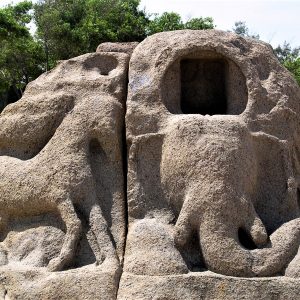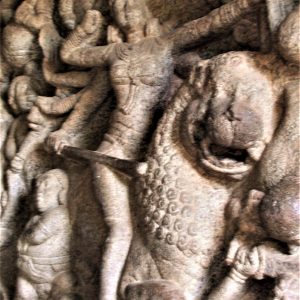Mahabalipuram-East Coast of India:The Lion Pillars – (2)
Mahabalipuram , an ancient coastal city on the East Coast of India was a thriving centre of international sea faring and trade known to the Romans as a prosperous port of antiquity. It was governed by various South Indian dynasties of which the most famous were the Pallavas (3rd-9th CE). The city flourished with art and architecture particularly in the 6th – 7th CE. A lion, either seated or rampant was the emblem of most of the Pallava kings appearing on the flags, coins and in architecture. Several kings had names which included ‘Simha’ or Lion.
The Pallavas were the first to carve temples out of stone either as free-standing monoliths or carved into caves which were themselves created from the gigantic granite boulders found in and around Mahabalipuram. The lion was a favourite theme and appears in various monuments.
The style of the pillars is unique to Pallava dynasty. The dating of the temples is made easier by subtle changes in the style of pillars. During the Mahendravarman period( 600-630 CE), the style of the pillar was an octagonal section between two cubical sections. This changed to a seated lion, or vyala, at the base of the pillar and a slender and tapering shaft above during the Narasimhavarman I period (630-668 CE) as seen in this photograph.
The lion changed from a seated form to a rampant lion during the rule of Narasimhavarma Pallava II known as Rajasimha (695-722 CE)
Prints : Available as Giclee print on finest quality paper or canvas. International shipment
Sizes available: 8 x 12″(203 x 305 mm); 12 x 16″(305 x 410mm); 18 x 24″(457 x 610 mm); 24 x 32″ (610 x 813mm)
For list of prices, details of paper or canvas and pigments used, please get in touch via contact form



